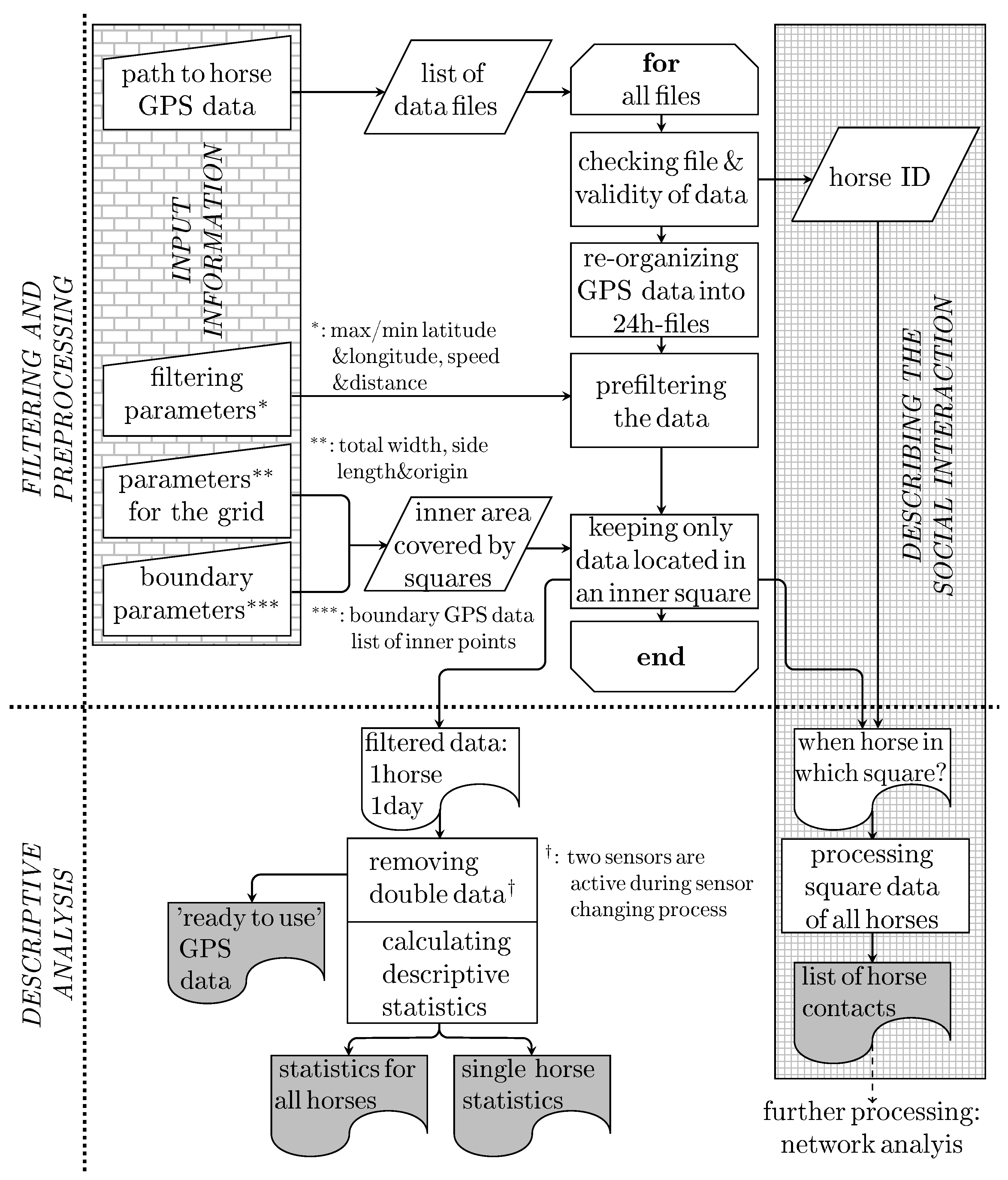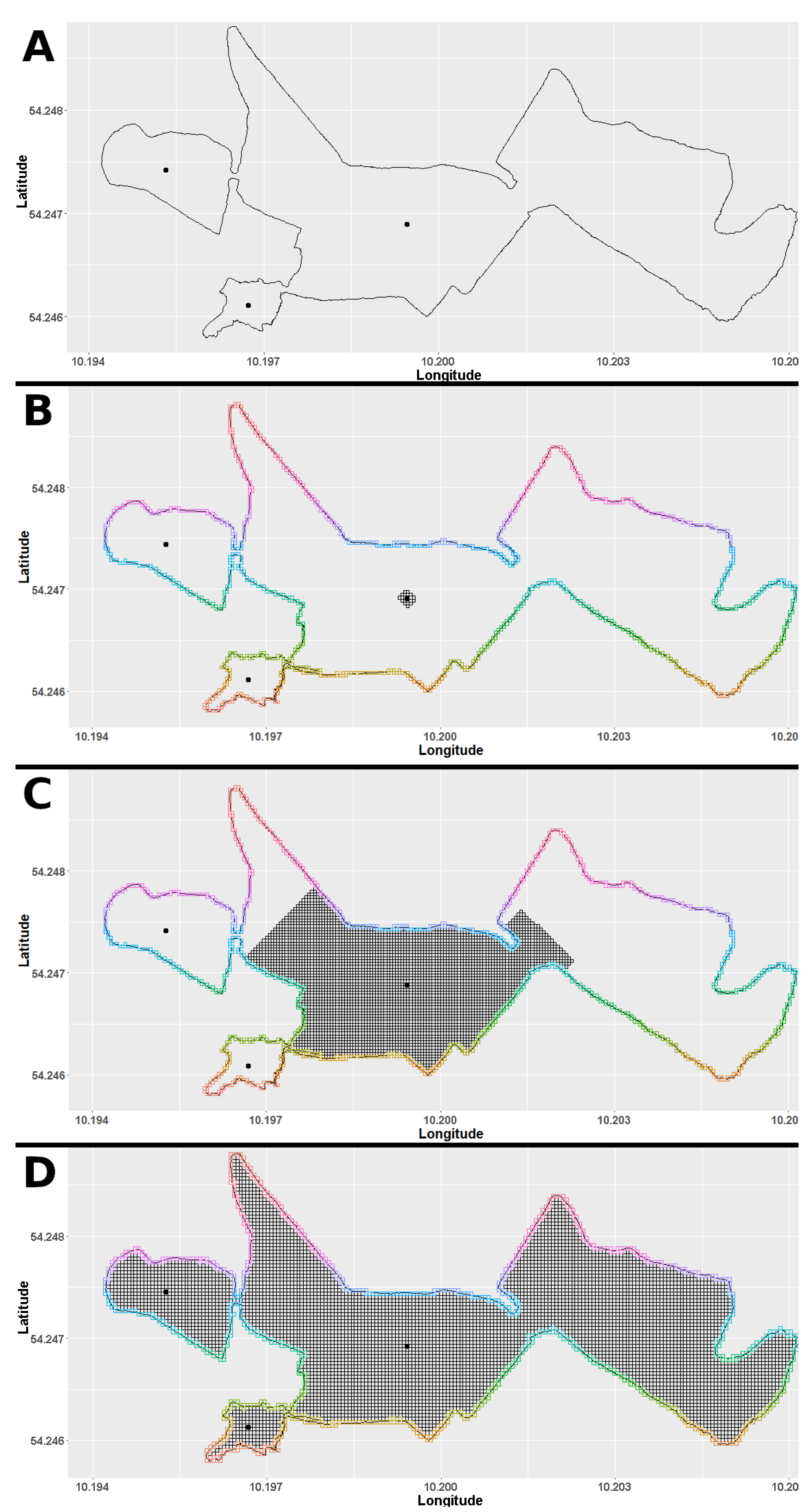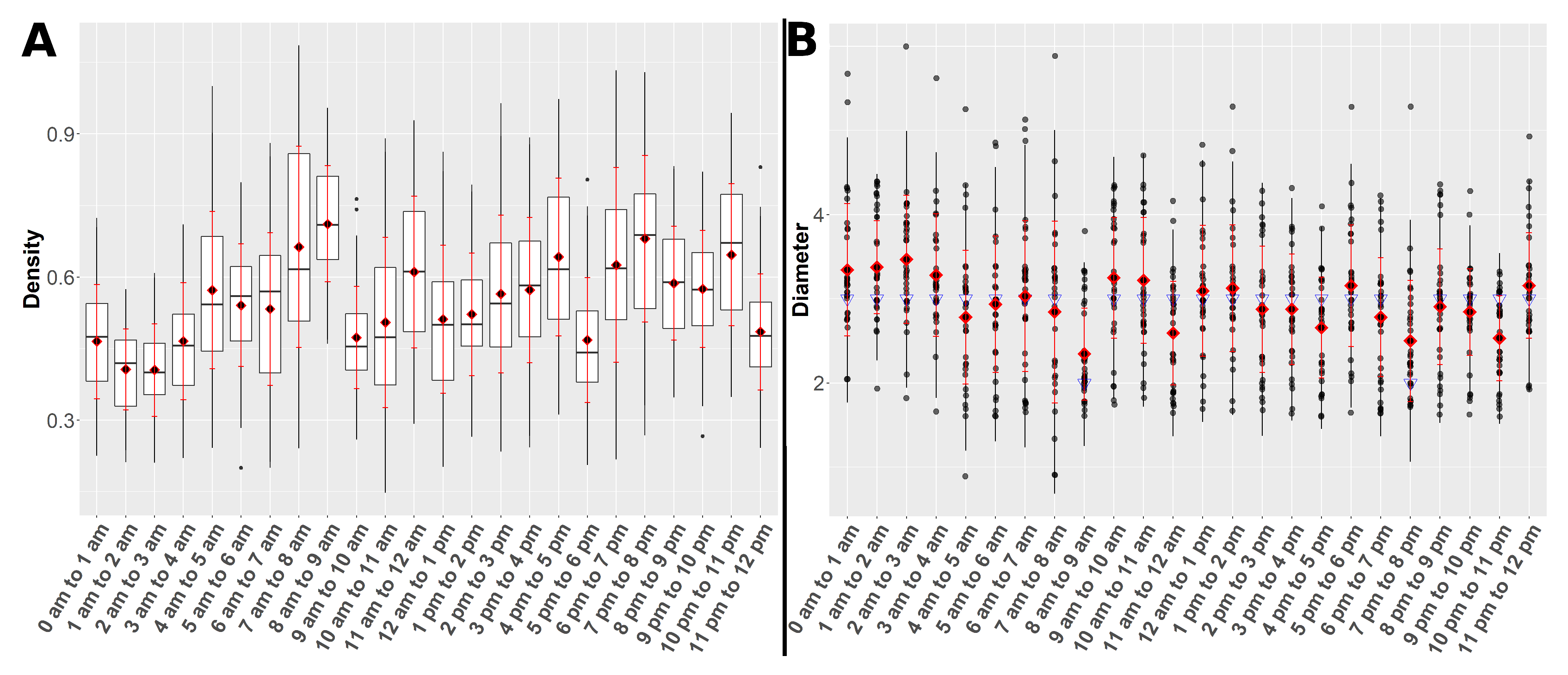“HerdGPS-Preprocessor”—A Tool to Preprocess Herd Animal GPS Data; Applied to Evaluate Contact Structures in Loose-Housing Horses
Abstract
Simple Summary
Abstract
1. Introduction
2. Materials and Methods
2.1. Data Collection
2.2. Ethical Statement
2.3. Data Preprocessing and Analysis of Contact Networks
3. Results
3.1. Software Tool “HerdGPS-Preprocessor”
3.1.1. Construction of a Grid on the Area of Observation
Grid
Ensuring a Closed Curve of Squares along the Boundary Data
Restricting the Grid to the Area of Observation
3.1.2. Filtering
Prefiltering
Filtering by Grid
3.1.3. Removing Overlapping Sensor Data
3.1.4. Calculation of Descriptive Statistics
3.1.5. Description of the Social Interactions
Time Windows
Contacts
3.2. Test of GPS Sensor Precision
3.3. Application of “HerdGPS-Preprocessor” to GPS Data of Horses
4. Discussion
5. Conclusions
Supplementary Materials
Author Contributions
Funding
Acknowledgments
Conflicts of Interest
References
- Will, M.K.; Büttner, K.; Kaufholz, T.; Müller-Graf, C.; Selhorst, T.; Krieter, J. Accuracy of a real-time location system in static positions under practical conditions: Prospects to track group-housed sows. Comput. Electron. Agric. 2017, 142, 473–484. [Google Scholar] [CrossRef]
- Rose, T. Real-Time Location System Series 7000 from Ubisense for Behavioural Analysis in Dairy Cows. Ph.D. Thesis, Institute of Animal Breeding and Husbandry, Kiel University, Kiel, Germany, 2015. [Google Scholar]
- Benaissa, S.; Tuyttens, F.; Plets, D.; Trogh, J.; Martens, L.; Vandaele, L.; Joseph, W.; Sonck, B. Calving and estrus detection in dairy cattle using a combination of indoor localization and accelerometer sensors. Comput. Electron. Agric. 2020, 168, 105153. [Google Scholar] [CrossRef]
- Gygax, L.; Neisen, G.; Wechsler, B. Socio-Spatial Relationships in Dairy Cows. Ethology 2010, 116, 10–23. [Google Scholar] [CrossRef]
- Miller, K.; Wood-Gush, D.G.M. Some effects of housing on the social behaviour of dairy cows. Anim. Sci. 2010, 53, 271–278. [Google Scholar] [CrossRef]
- Boyland, N.K.; Mlynski, D.T.; James, R.; Brent, L.J.N.; Croft, D.P. The social network structure of a dynamic group of dairy cows: From individual to group level patterns. Appl. Anim. Behav. Sci. 2016, 174, 1–10. [Google Scholar] [CrossRef]
- O’Neill, C.J.; Bishop-Hurley, G.J.; Williams, P.J.; Reid, D.J.; Swain, D.L. Using UHF proximity loggers to quantify male–female interactions: A scoping study of estrous activity in cattle. Anim. Reprod. Sci. 2014, 151, 1–8. [Google Scholar] [CrossRef] [PubMed]
- Rose-Meierhöfer, S.; Klaer, S.; Ammon, C.; Brunsch, R.; Hoffmann, G. Activity Behavior of Horses Housed in Different Open Barn Systems. J. Equine Vet. Sci. 2010, 30, 624–634. [Google Scholar] [CrossRef]
- Gabrieli, R. Evaluating social behaviour in grazing beef cows through online activity monitoring. In Proceedings of the DairyCare Workshop: ‘Activity Measurement in Ruminant Researchand Beyond’, Leeuwarden, The Netherlands, 20–21 June 2016. [Google Scholar]
- Gülden, A.; Schulze Zurmussen, H.; Büscher, W. The effect of different feeding regimes on horses’ blocking and activity behavior at a concentrate feeding station for horses in group housing. J. Vet. Behav. 2018, 24, 27–35. [Google Scholar] [CrossRef]
- Koene, P.; Hogewerf, P.; Ipema, B. Dairy cow welfare: Effects of a virtual fence on social behavior. In Precision Dairy Farming 2016; Kamphuis, C., Ed.; Wageningen Academic Publishers: Wageningen, The Netherlands, 2016; pp. 337–341. [Google Scholar]
- Rupi, F.; Poliziani, C.; Schweizer, J. Analysing the dynamic performances of a bicycle network with a temporal analysis of GPS traces. Case Stud. Transp. Policy 2020, in press. [Google Scholar] [CrossRef]
- Hocke, K.; Pavelyev, A. General aspect of GPS data use for atmospheric science. Adv. Space Res. 2001, 27, 1313–1320. [Google Scholar] [CrossRef]
- Van den IJssel, J.; Doornbos, E.; Iorfida, E.; March, G.; Siemes, C.; Montenbruck, O. Thermosphere densities derived from Swarm GPS observations. Adv. Space Res. 2020, 65, 1758–1771. [Google Scholar] [CrossRef]
- Kim, B.; Regan, S.D.; Callander, D.; Goedel, W.C.; Chaix, B.; Duncan, D.T. Associations of spatial mobility with sexual risk behaviors among young men who have sex with men in New York City: A global positioning system (GPS) study. Soc. Sci. Med. 2020, 258, 113060. [Google Scholar] [CrossRef] [PubMed]
- Alchalbi, A.; Daoud, M.; Gomez, F.; McClusky, S.; Reilinger, R.; Romeyeh, M.A.; Alsouod, A.; Yassminh, R.; Ballani, B.; Darawcheh, R.; et al. Crustal deformation in northwestern Arabia from GPS measurements in Syria: Slow slip rate along the northern Dead Sea Fault. Geophys. J. Int. 2010, 180, 125–135. [Google Scholar] [CrossRef]
- Alif, S.M.; Fattah, E.I.; Kholil, M. Geodetic slip rate and locking depth of east Semangko Fault derived from GPS measurement. Geodesy Geodyn. 2020, in press. [Google Scholar] [CrossRef]
- Millward, M.F.; Bailey, D.W.; Cibils, A.F.; Holechek, J.L. A GPS based evaluation of factors commonly used to adjust cattle stocking rates on both extensive and mountainous rangelands. Rangelands 2020, in press. [Google Scholar] [CrossRef]
- Davis, J.; Darr, M.; Xin, H.; Harmon, J.; Russell, J. Development of a GPS Herd Activity and Well- Being Kit (GPS HAWK) to Monitor Cattle Behavior and the Effect of Sample Interval on Travel Distance. Appl. Eng. Agric. 2011, 27. [Google Scholar] [CrossRef]
- De Weerd, N.; van Langevelde, F.; van Oeveren, H.; Nolet, B.A.; Kölzsch, A.; Prins, H.H.T.; de Boer, W.F. Deriving Animal Behaviour from High-Frequency GPS: Tracking Cows in Open and Forested Habitat. PLoS ONE 2015, 10, e0129030. [Google Scholar] [CrossRef]
- Zillner, J.C.; Tücking, N.; Plattes, S.; Heggemann, T.; Büscher, W. Using walking speed for lameness detection in lactating dairy cows. Livest. Sci. 2018, 218, 119–123. [Google Scholar] [CrossRef]
- Zebari, H.M.; Rutter, S.M.; Bleach, E.C. Characterizing changes in activity and feeding behaviour of lactating dairy cows during behavioural and silent oestrus. Appl. Anim. Behav. Sci. 2018, 206, 12–17. [Google Scholar] [CrossRef]
- Kaczensky, P.; Ganbaatar, O.; Von Wehrden, H.; Walzer, C. Resource selection by sympatric wild equids in the Mongolian Gobi. J. Appl. Ecol. 2008, 45, 1762–1769. [Google Scholar] [CrossRef]
- Hennig, J.D.; Beck, J.L.; Scasta, J.D. Spatial Ecology Observations from Feral Horses Equipped with Global Positioning System Transmitters. Human-Wildl. Interact. 2018, 12, 75–84. [Google Scholar] [CrossRef]
- Hampson, B.A.; De Laat, M.A.; Mills, P.C.; Pollitt, C.C. Distances travelled by feral horses in ’outback’ Australia. Equine Vet. J. 2010, 42, 582–586. [Google Scholar] [CrossRef] [PubMed]
- Pikuła, R.; Zaborski, D.; Grzesiak, W.; Smuga, M. Locomotor activity analysis based on habitat, season and time of the day in Polish Konik horses from reserve breeding using the Global Positioning System (GPS). Indian J. Anim. Res. 2020, 54, 494–498. [Google Scholar] [CrossRef]
- Hildebrandt, F.; Krieter, J.; Büttner, K.; Salau, J.; Czycholl, I. Distances walked by long established and newcomer horses in an open stable system in Northern Germany. J. Equine Vet. Sci. 2020, in press. [Google Scholar] [CrossRef]
- Vázquez Diosdado, J.A.; Barker, Z.E.; Hodges, H.R.; Amory, J.R.; Croft, D.P.; Bell, N.J.; Codling, E.A. Space-use patterns highlight behavioural differences linked to lameness, parity, and days in milk in barn-housed dairy cows. PLoS ONE 2018, 13, e0208424. [Google Scholar] [CrossRef]
- Salau, J.; Krieter, J. Analysing the Space-Usage-Pattern of a cow herd using video surveillance and automated motion detection. Biosyst. Eng. 2020, in press. [Google Scholar] [CrossRef]
- Wasserman, S.; Faust, K. Social Network Analysis: Methods and Applications; Cambridge University Press: New York, NY, USA, 1994. [Google Scholar]
- Newman, M. Networks—An Introduction; Oxford University Press Inc.: New York, NY, USA, 2010. [Google Scholar]
- Salau, J.; Lamp, O.; Krieter, J. Dairy cows’ contact networks derived from videos of eight cameras. Biosyst. Eng. 2019, 188, 106–113. [Google Scholar] [CrossRef]
- Stanley, C.R.; Mettke-Hofmann, C.; Hager, R.; Shultz, S. Social stability in semiferal ponies: Networks show interannual stability alongside seasonal flexibility. Anim. Behav. 2018, 136, 175–184. [Google Scholar] [CrossRef]
- Wey, T.; Blumstein, D.T.; Shen, W.; Jordán, W. Social network analysis of animal behaviour: A promising tool for the study of sociality. Anim. Behav. 2008, 75, 333–344. [Google Scholar] [CrossRef]
- Büttner, K.; Scheffler, K.; Czycholl, I.; Krieter, J. Network characteristics and development of social structure of agonistic behaviour in pigs across three repeated rehousing and mixing events. Appl. Anim. Behav. Sci. 2015, 168, 24–30. [Google Scholar] [CrossRef]
- Büttner, K.; Scheffler, K.; Czycholl, I.; Krieter, J. Social network analysis—Centrality parameters and individual network positions of agonistic behavior in pigs over three different age levels. SpringerPlus 2015, 4, 185. [Google Scholar] [CrossRef] [PubMed]
- Büttner, K.; Czycholl, I.; Mees, K.; Krieter, J. Agonistic Interactions in Pigs—Comparison of Dominance Indices with Parameters Derived from Social Network Analysis in Three Age Groups. Animals 2019, 9, 929. [Google Scholar] [CrossRef] [PubMed]
- Büttner, K.; Czycholl, I.; Mees, K.; Krieter, J. Temporal development of agonistic interactions as well as dominance indices and centrality parameters in pigs after mixing. Appl. Anim. Behav. Sci. 2020, 222, 104913. [Google Scholar] [CrossRef]
- Firestone, S.M.; Lewis, F.I.; Schemann, K.; Ward, M.P.; Toribio, J.A.L.; Taylor, M.R.; Dhand, N.K. Applying Bayesian network modelling to understand the links between on-farm biosecurity practice during the 2007 equine influenza outbreak and horse managers’ perceptions of a subsequent outbreak. Prev. Vet. Med. 2014, 116, 243–251. [Google Scholar] [CrossRef] [PubMed]
- Liebenberg, D.; Piketh, S.; van Hamburg, H. A web based survey of horse owners’ perceptions and network analysis of horse movements relating to African horse sickness distribution in Namibia and South Africa. Acta Trop. 2016, 158, 201–207. [Google Scholar] [CrossRef]
- Büttner, K.; Salau, J.; Krieter, J. Quality assessment of static aggregation compared to the temporal approach based on a pig trade network in Northern Germany. Prev. Vet. Med. 2016, 129, 1–8. [Google Scholar] [CrossRef]
- Büttner, K.; Salau, J.; Krieter, J. Effects of data quality in an animal trade network and their impact on centrality parameters. Soc. Netw. 2018, 54, 73–81. [Google Scholar] [CrossRef]
- Milwid, R.M.; O’Sullivan, T.L.; Poljak, Z.; Laskowski, M.; Greer, A.L. Comparison of the dynamic networks of four equine boarding and training facilities. Prev. Vet. Med. 2019, 162, 84–94. [Google Scholar] [CrossRef]
- Mitlöhner, F.M.; Morrow-Tesch, J.L.; Wilson, S.C.; Dailey, J.W.; McGlone, J.J. Behavioral sampling techniques for feedlot cattle. J. Anim. Sci. 2001, 79, 1189–1193. [Google Scholar] [CrossRef]
- Mattachini, G.; Riva, E.; Provolo, G. The lying and standing activity indices of dairy cows in free-stall housing. Appl. Anim. Behav. Sci. 2011, 129, 18–27. [Google Scholar] [CrossRef]
- Friard, O.; Gamba, M. BORIS: A free, versatile open-source event-logging software for video/audio coding and live observations. Methods Ecol. Evol. 2016, 7. [Google Scholar] [CrossRef]
- Guzhva, O.; Ardö, H.; Herlin, A.; Nilsson, M.; Åström, K.; Bergsten, C. Feasibility study for the implementation of an automatic system for the detection of social interactions in the waiting area of automatic milking stations by using a video surveillance system. Comput. Electron. Agric. 2016, 127, 506–509. [Google Scholar] [CrossRef]
- Salau, J.; Haas, J.H.; Junge, W.; Thaller, G. Automated calculation of udder depth and rear leg angle in Holstein-Friesian cows using a multi-Kinect cow scanning system. Biosyst. Eng. 2017, 160, 154–169. [Google Scholar] [CrossRef]
- Song, X.; Bokkers, E.; van Mourik, S.; Koerkamp, P.G.; van der Tol, P. Automated body condition scoring of dairy cows using 3-dimensional feature extraction from multiple body regions. J. Dairy Sci. 2019, 102, 4294–4308. [Google Scholar] [CrossRef]
- Bonneau, M.; Vayssade, J.A.; Troupe, W.; Arquet, R. Outdoor animal tracking combining neural network and time-lapse cameras. Comput. Electron. Agric. 2020, 168, 105150. [Google Scholar] [CrossRef]
- Best, R.; Standing, R. Feasibility of a Global Positioning System to Assess the Spatiotemporal Characteristics of Polo Performance. J. Equine Vet. Sci. 2019, 79, 59–62. [Google Scholar] [CrossRef]
- Munsters, C.C.; Kingma, B.R.; van den Broek, J.; Sloet van Oldruitenborgh-Oosterbaan, M.M. A prospective cohort study on the acute chronic workload ratio in relation to injuries in high level eventing horses: A comprehensive 3-year study. Prev. Vet. Med. 2020, 179, 105010. [Google Scholar] [CrossRef]
- R Core Team. R: A Language and Environment for Statistical Computing; R Foundation for Statistical Computing: Vienna, Austria, 2018. [Google Scholar]
- Salau, J. “HerdGPS-Preprocessor”—Software to Preprocess GPS Data Collected from Herd Animals, Written in R 3.5. 2020. Available online: https://github.com/jsalau/HerdGPS-Preprocessor (accessed on 20 October 2020).
- Tsai, R.Y. Radiometry; Chapter A Versatile Camera Calibration Technique for High-accuracy 3D Machine Vision Metrology Using Off-the-shelf TV Cameras and Lenses; Jones and Bartlett Publishers, Inc.: Burlington, VT, USA, 1992; pp. 221–244. [Google Scholar]
- Baker, P.; Aloimonos, Y. Complete calibration of a multi-camera network. In Omnidirectional Vision; IEEE: New York, NY, USA, 2000; pp. 134–141. [Google Scholar] [CrossRef]
- Salau, J.; Haas, J.H.; Junge, W.; Thaller, G. Extrinsic calibration of a multi-Kinect camera scanning passage for measuring functional traits in dairy cows. Biosyst. Eng. 2016, 151, 409–424. [Google Scholar] [CrossRef]
- Søndergaard, E.; Turner, K.C. Timeframe for a novel horse to become familiar in a group. In IESM 2008; Krüger, K., Ed.; Xenophon Verlag: Munich, Germany, 2008. [Google Scholar]
- Zeitler-Feicht, M.H.; Westphal, M.; Dempfle, L. Agonistische Verhaltensweisen von Pferden in Offenlaufställen unter besonderer Berücksichtigung der Unterlegenheitsgesten (The agonistic behaviour pattern of horses in loose housing systems with open yards with particular emphasis on submissive gestures). In Proceedings of the Arbeiten zur ArtgemäßEn Tierhaltung 2006: Current Research in Applied Ethology, Vorträge anlässlich der 38, Freiburg im Breisgau, Germany, 23–25 November 2006. [Google Scholar]
- Czycholl, I.; Kniese, C.; Büttner, K.; Grosse Beilage, E.; Schrader, L.; Krieter, J. Interobserver reliability of the ‘Welfare Quality® Animal Welfare Assessment Protocol for Growing Pigs’. SpringerPlus 2016, 5, 1114. [Google Scholar] [CrossRef]
- Shamoun-Baranes, J.; Bom, R.; van Loon, E.E.; Ens, B.J.; Oosterbeek, K.; Bouten, W. From Sensor Data to Animal Behaviour: An Oystercatcher Example. PLoS ONE 2012, 7, e0037997. [Google Scholar] [CrossRef]
- Hebblewhite, M.; Haydon, D.T. Distinguishing technology from biology: A critical review of the use of GPS telemetry data in ecology. Philos. Trans. R. Soc. Lond. Ser. B Biol. Sci. 2010, 365, 2303–2312. [Google Scholar] [CrossRef] [PubMed]
- Owen-Smith, N.; Fryxell, J.; Merrill, E. Foraging theory upscaled: The behavioural ecology of herbivore movement. Philos. Trans. R. Soc. Lond. Ser. B Biol. Sci. 2010, 365, 2267–2278. [Google Scholar] [CrossRef]
- Zeitler-Feicht, M.H. Verhalten von Pferden. In Nutztierethologie; Hoy, S., Ed.; Ulmer-Verlag: Stuttgart, Germany, 2009. [Google Scholar]
- Gomez-Gil, J.; Ruiz-Gonzalez, R.; Alonso-Garcia, S.; Gomez-Gil, F.J. A Kalman Filter Implementation for Precision Improvement in Low-Cost GPS Positioning of Tractors. Sensors 2013, 13, 15307–15323. [Google Scholar] [CrossRef]
- Deep, A.; Mittal, M.; Mittal, V. Application of Kalman Filter in GPS Position Estimation. In Proceedings of the 2018 IEEE 8th Power India International Conference (PIICON), Kurukshetra, India, 10–12 December 2018; pp. 1–5. [Google Scholar]
- Petris, G. An R Package for Dynamic Linear Models. J. Stat. Softw. 2010, 36, 1–16. [Google Scholar] [CrossRef]
- Büttner, K.; Salau, J.; Krieter, J. Temporal correlation coefficient for directed networks. SpringerPlus 2016, 1198. [Google Scholar] [CrossRef][Green Version]
- Lesimple, C.; Gautier, E.; Benhajali, H.; Rochais, C.; Lunel, C.; Bensaïd, S.; Khalloufi, A.; Henry, S.; Hausberger, M. Stall architecture influences horses’ behaviour and the prevalence and type of stereotypies. Appl. Anim. Behav. Sci. 2019, 219, 104833. [Google Scholar] [CrossRef]
- Bueno Ribeiro, L.; Vasconcelos Matzkeit, T.; Teodoro de Souza Nicolau, J.; Castilha, L.D.; Cortez Leite de Oliveira, F.; Bankuti, F.I. Determinants of Undesirable Behaviors in American Quarter Horses Housed in Box Stalls. J. Equine Vet. Sci. 2019, 80, 69–75. [Google Scholar] [CrossRef]
- Lesimple, C.; Reverchon-Billot, L.; Galloux, P.; Stomp, M.; Boichot, L.; Coste, C.; Henry, S.; Hausberger, M. Free movement: A key for welfare improvement in sport horses? Appl. Anim. Behav. Sci. 2020, 225, 104972. [Google Scholar] [CrossRef]
- Waring, G.H. Horse Behavior. In Noyes Series in Animal Behavior, Ecology, Conservation and Management, 2nd ed.; Noyes Publications William Andrew Publishing: Norwich, NY, USA, 2003. [Google Scholar]
- Ingram, D.; Dauncey, M. Circadian rhythms in the pig. Comp. Biochem. Physiol. Part A Physiol. 1985, 82, 1–5. [Google Scholar] [CrossRef]
- Boyd, L.E. Time budgets of adult Przewalski horses: Effects of sex, reproductive status and enclosure. Appl. Anim. Behav. Sci. 1988, 21, 19–39. [Google Scholar] [CrossRef]
- Meisfjord Jørgensen, G.H.; Hanche-Olsen Liestøl, S.H.; Bøe, K.E. Effects of enrichment items on activity and social interactions in domestic horses (Equus caballus). Appl. Anim. Behav. Sci. 2011, 129, 100–110. [Google Scholar] [CrossRef]
- Winther Christensen, J.; Søndergaard, E.S.; Thodberg, K.; Halekoh, U. Effects of repeated regrouping on horse behaviour and injuries. Appl. Anim. Behav. Sci. 2011, 133, 199–206. [Google Scholar] [CrossRef]
- Hartmann, E.; Søndergaard, E.; Keeling, L.J. Keeping horses in groups: A review. Appl. Anim. Behav. Sci. 2012, 136, 77–87. [Google Scholar] [CrossRef]







| Side | Points of org. Boundary | Points of Filled up Boundary | No. Boundary Squares org. | No. Boundary Squares Filled | No. Area Squares |
|---|---|---|---|---|---|
| 10 m | 4641 | 4652 | 567 | 647 | 3324 |
| 6 m | 4641 | 4716 | 930 | 1100 | 8868 |
| 5 m | 4641 | 4893 | 1111 | 1303 | 12,633 |
| 4 m | 4641 | 5200 | 1360 | 1649 | 19,551 |
| 3.5 m | 4641 | 5636 | 1803 | 1886 | 25,420 |
| 3 m | 4641 | 6302 | 1803 | 2196 | 34,391 |
| 2.5 m | 4641 | 7402 | 2141 | 2614 | 49,233 |
| 2 m | 4641 | 8665 | 2577 | 3309 | 76,567 |
| 1.5 m | 4641 | 11,734 | 3242 | 4402 | 135,397 |
| 1 m | 4641 | 17,049 | 4108 | 6672 | 303,013 |
Publisher’s Note: MDPI stays neutral with regard to jurisdictional claims in published maps and institutional affiliations. |
© 2020 by the authors. Licensee MDPI, Basel, Switzerland. This article is an open access article distributed under the terms and conditions of the Creative Commons Attribution (CC BY) license (http://creativecommons.org/licenses/by/4.0/).
Share and Cite
Salau, J.; Hildebrandt, F.; Czycholl, I.; Krieter, J. “HerdGPS-Preprocessor”—A Tool to Preprocess Herd Animal GPS Data; Applied to Evaluate Contact Structures in Loose-Housing Horses. Animals 2020, 10, 1932. https://doi.org/10.3390/ani10101932
Salau J, Hildebrandt F, Czycholl I, Krieter J. “HerdGPS-Preprocessor”—A Tool to Preprocess Herd Animal GPS Data; Applied to Evaluate Contact Structures in Loose-Housing Horses. Animals. 2020; 10(10):1932. https://doi.org/10.3390/ani10101932
Chicago/Turabian StyleSalau, Jennifer, Frederik Hildebrandt, Irena Czycholl, and Joachim Krieter. 2020. "“HerdGPS-Preprocessor”—A Tool to Preprocess Herd Animal GPS Data; Applied to Evaluate Contact Structures in Loose-Housing Horses" Animals 10, no. 10: 1932. https://doi.org/10.3390/ani10101932
APA StyleSalau, J., Hildebrandt, F., Czycholl, I., & Krieter, J. (2020). “HerdGPS-Preprocessor”—A Tool to Preprocess Herd Animal GPS Data; Applied to Evaluate Contact Structures in Loose-Housing Horses. Animals, 10(10), 1932. https://doi.org/10.3390/ani10101932





